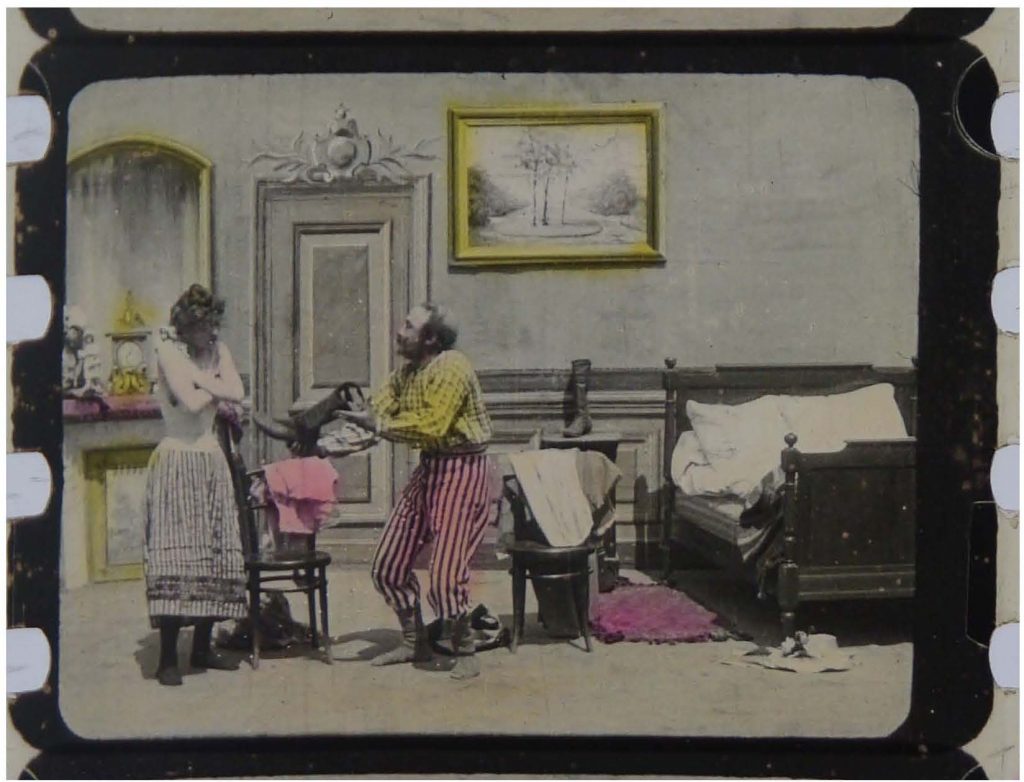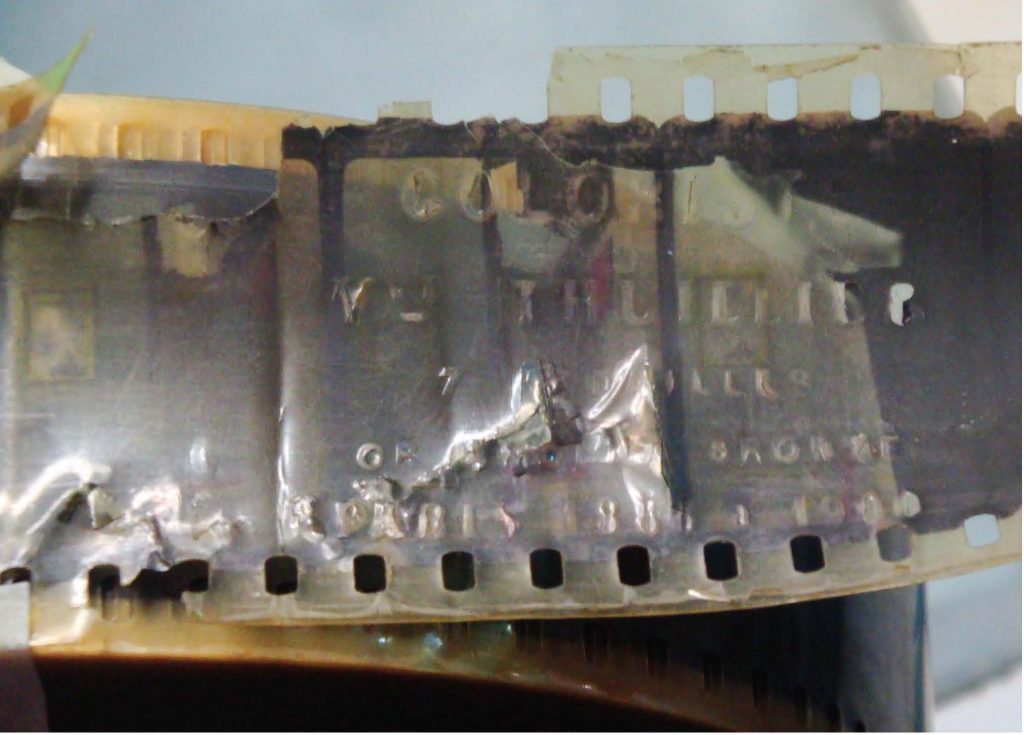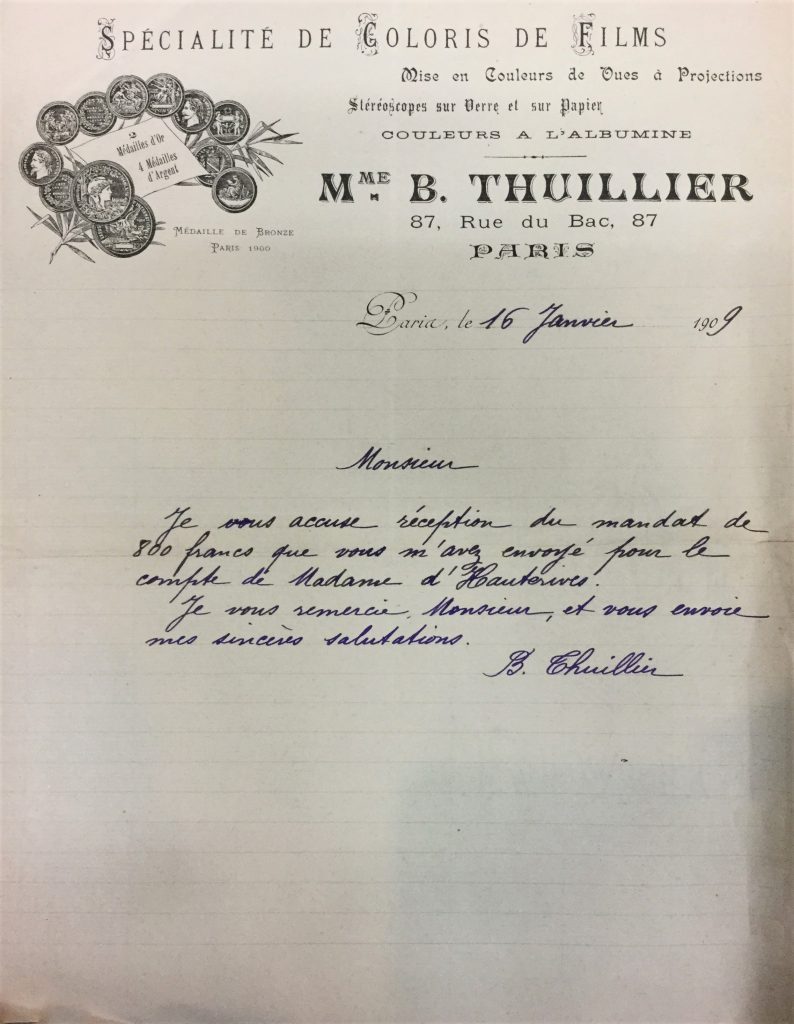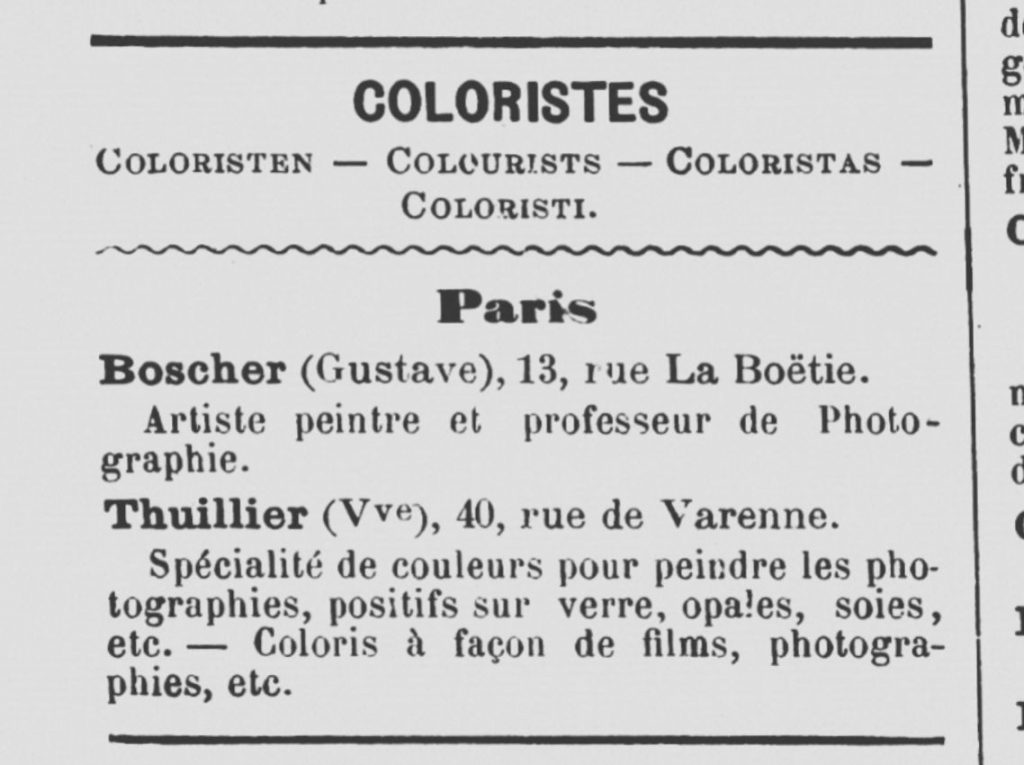Élisabeth Thuillier is best known by film historians for having colored Georges Méliès’s films and films produced by Pathé. In his overview essay on “French Film Colorists” written for this publication, Joshua Yumibe notes that Méliès “outsourced his hand-coloring work from 1897 to 1912 to a Vincennes firm in Paris run by Elisabeth Thuillier who managed a workforce of over 200 female colorists.” Like other film historians before him, Yumibe relies on the journalist François Mazeline’s interview with “Mme Thuillier,” which took place just a few days before a gala organized in honor of Méliès at the Salle Pleyel in Paris in 1929. In that interview, “Mme Thuillier” told Mazeline:
I did the coloring for all of M. Méliès’s films (…). That type of coloring was entirely done by hand. I employed two hundred and twenty women in my workshop. I spent my nights selecting and sampling the colors, and during the day, my workers applied the color according to my instructions. Each specialized worker applied only one color, and there were often more than twenty colors to apply on one film. We used very fine aniline dyes. They were then successively dissolved in water and alcohol. The tone obtained was transparent and luminous. The false tints were not neglected. (…) M. Dufayel was my last client. He always demanded that the films be hand-colored. The cost was higher, six to seven thousand Francs per copy, for a 300-meter film, and that was before the war. We made an average of sixty copies for each film. So, hand-coloring was a fairly heavy burden on producers’ budgets. (Mazeline 4)

Georges Méliès’s notebook, ca. 1930. Courtesy of the Centre national du cinéma et de l’image animée and the Cinémathèque française.
But contrary to what we thought for so long, the woman cited above was not Élisabeth Thuillier but her daughter Marie-Berthe Thuillier, known as Berthe Thuillier, who probably worked with Élisabeth and then took over the workshop after her death in either 1904 or 1907. Only recently did we find out about Berthe Thuillier thanks to Georges Méliès’s address book from the 1930s, which indicates the city where “Mrs. Thuillier” lived. The address book reads as follows: “Mrs. Thuillier—Film colorist in Forceville-en-Vimeu near Oisemont (Somme)” (Fonds Méliès 55-B5). We then followed this first lead to various private, national, regional, and local archives, where we uncovered information about Berthe, her mother Élisabeth, and their career as film colorists during the early days of cinema.
Élisabeth Thuillier (née Aléné) was born in 1841 in the town of Guénange in Moselle (near the French border with Luxembourg and Prussia) to a family of Catholic farmers. After the Franco-Prussian War, the Moselle region was annexed by Prussia, but in 1872, Élisabeth chose to keep the French nationality. She had six siblings and her father lived in Paris where he made a modest living as an unskilled worker. Around 1848-1850, when social upheavals and cholera epidemics forced populations in France to migrate from rural to urban areas, Élisabeth left her village and moved to Paris with three of her older siblings. In Paris, she was apparently under the responsibility of her brothers and sisters, with whom she maintained a close relationship for many years. According to official documents from the État civil de Paris at the Archives de Paris, her siblings were with her in 1864 and 1865, when she gave birth to two children “of unknown father,” and when they both died in infancy. In 1867, Élisabeth’s third child, Marie-Berthe, was born and recognized legally by her father, Jules Arthur Thuillier (1846-1875), the son of a landowner from Forceville-en-Vimeu (Somme), even though Élisabeth and Jules were not officially married until 1874.
When she first arrived in Paris, Élisabeth lived in a working-class neighborhood bordered by the Canal Saint-Martin on one side and gypsum quarries on the other, on the site of the Octroi Wall and on the edge of La Villette and Belleville, two villages in the North of Paris that were incorporated into the capital in 1860. Because of the Falloux Law of 1850, which required that every commune of more than 500 inhabitants have a public school for boys and girls, both Élisabeth and Berthe were able to go to public school and to receive a good education. Berthe’s education was probably better than her mother’s since the Falloux Law had been in place for about twenty years when she lived with her paternal aunt in Quevauvillers, a town of about 1000 people in the Somme. Yet Élisabeth still benefitted from the development of new economic opportunities during the Second Empire (1852-1870). As suggested by the address listed on Berthe’s birth certificate from 1867, Élisabeth, who had been a cook and a house servant before, was now working as an “employee” at A. Binant’s shop (5-7 rue de Cléry, 2nd arrondissement). Binant, whose successor would be E. Souchard, was an art dealer who sold “all sorts of watercolors, gouache colors, miniature paints, oil colors, and paint tubes” (Annuaire-almanach du commerce 758), as well as restored paintings, specialized in marouflage on canvas, and published Gustave le Gray’s Nouveau traité théorique et pratique de la photographie sur papier et sur verre [New theoretical and practical treatise on photography, upon paper and glass] (1851). Little information remains about the following years of Élisabeth’s career, when she started her own business as a colorist of photographs and positive plates. Yet it was most likely after she became a widow in 1875 that she started practicing coloring on her own. Although Jules Arthur Thuillier had become a lawyer after having been a shopkeeper, he died without leaving Élisabeth anything, which means that she might have opened her own business out of financial necessity after he died. Under the Napoleonic Code, her status as a widow allowed her to earn a living and support her family on her own.
As for Berthe, she might have started working with her mother around 1886, when she was nineteen years old. Or Berthe might have been employed by Albert Saulieu, a photographer who was a witness at her wedding in 1888. Official documents issued by the État Civil around that time indicate that Berthe was herself a photographer, which was still a very rare profession for a woman, and that she remained a photographer until at least 1889, when her only daughter, Georgette, was born. Berthe might have signed her photographs with the name of her husband Eugène Boutier, a sculptor who attended the École nationale supérieure des Arts Décoratifs starting in 1885 and who displayed a bust of “Mlle B.T.” (probably Berthe Thuillier) at the Salon of 1887 (Exposition des Beaux-Arts 47). Berthe and her husband belonged to the thriving community of Parisian artists and lived on the rue André-del-Sarte in Montmartre, near the Grands Magasins Dufayel, which would later show some films that would have been colored by the Thuilliers (Mazeline 4). Berthe and Eugène’s separation in 1902, followed by their divorce upon Berthe’s request in 1906, might be the reason why she then used Thuillier as her professional name.
With the emergence of cinema in 1895, Élisabeth and Berthe started specializing in the coloring of films using the same aniline dyes that were already employed for photographs and stereoscopic glass prints. Yet their business is not listed in the extant professional directories of the time that we consulted. Because the Thuilliers specialized in coloring, their business might have been quite modest at first, or they might have done subcontracted work for a photographer. In any case, the Thuilliers might have started working for Méliès as early as 1897 since Méliès considered colors essential to the visual spectacle that his féeries and trick films offered to audiences already used to colorful magic lantern shows (Malthête 1987, 6). Méliès probably designed the sets, costumes, and tricks in most of his films knowing what colors he would instruct the Thuilliers to apply later (3). But at the same time, the Thuilliers might have had some control over the coloring process since “colors often varied from one print to the next based on the head colorist’s taste and skillfulness” (3). During her interview with Mazeline in 1929, Berthe also stated that, “I spent my nights selecting and sampling the colors” (4), which certainly suggests that she made at least some of the decisions about the coloring of Méliès’s films.

Frame enlargement, Monsieur et Madame sont pressés (colored nitrate, Pathé frères, 1902). Courtesy of Filmoteca Vasca and Filmoteca de Catalunya.

Embossed stamp, “Coloriste Vve Thuillier” at the end of Monsieur et Madame sont pressés. Courtesy of Filmoteca Vasca and Filmoteca de Catalunya.
At Pathé, the first mentions of “Thuillier, Coloriste” and “Vve Thuillier” [Widow Thuillier] in the bookkeeping records date back to January 4, 1898, and February 12, 1898, respectively (Journaux comptables de Pathé 8, 115). Yet the Thuilliers might have worked for Pathé frères before that, when the firm had not yet been formed as a limited company. At any rate, the Filmoteca de Catalunya recently restored a fragment from the hand-colored nitrate print of a film released by the company in 1902 entitled Monsieur et Madame sont pressés/In A Hurry to Catch A Train, which bears the following mention (in French): “COLORISTE/Vve THUILLIER /7 MEDAILLES/OR ARGENT BRONZE/PARIS 1886 A 1900” [Colorist/Widow Thuillier/7 medals/gold silver bronze/Paris 1886-1900]. According to archivists Nere Pagola and Joxean Fernández, this fragment is “particularly interesting since there is apparently no other film whose coloring can be attributed directly to the famous colorist’s workshop” (97). But if we are unable to establish the Thuilliers’ filmography, then we can say that they most likely worked on a large number of Pathé films from at least 1898 until around 1912. Based on Pathé’s bookkeeping records, by November 1903, Pathé was working with three different workshops: Verdier, Vallouy, and Thuillier. At that point, the firm was just a few months away from its first trials for mechanized coloring. During the second half of 1905, Pathé placed orders mostly from the Thuilliers, who would deliver up to 3,800 meters of film every month for the price of 1.25 Francs per meter, even though stencils had just been introduced at Vincennes. At the Archives départementales du Finistère in Brittany, letters dated 1908 and 1909 and written from Bermuda by film exhibitor Marie de Kerstrat to Francis Gaouyer, her law clerk, and two letters from Berthe to Gaouyer, suggest that Berthe (and perhaps her mother before her) worked with at least one other film organization besides Méliès and Pathé around the same time (Fonds Pouliquen).

Berthe Thuillier’s writing paper, 1909. Courtesy of Archives départementales du Finistère (Fonds Pouliquen).
Today there is still very little published scholarship about Élisabeth and Berthe. Yet official records, directories, and the Thuilliers’ administrative papers from the beginning of the twentieth century show that their contributions to photography (and possibly film) were acknowledged by their peers. For example, Élisabeth was awarded a bronze medal at the 1900 Paris Exposition (L’Exposition universelle 163; “1° Liste” 149), where she competed as an expert in “albumen colors,” which she had used since at least 1896, probably because they allowed for precise and transparent corrections on photographic prints (Exposition internationale du théâtre et de la musique 132). The Annuaire du commerce et de l’industrie photographiques from 1902 also mentions that “Mme Vve Thuillier” [Élisabeth Thuillier] specialized in the application of “colors for painting photographs, positives on glass, opals, and silks, etc.,” and that she “colored any film and photograph” (118), which no other listed professional seems to have offered. Based on the Annuaire-almanach du commerce, where the Thuillier name was listed between 1903 and 1909, the Thuillier workshop received three gold medals, one vermeil medal, one silver medal, and one bronze medal (abbreviated as “OOO, V, A, B” in French). The heading on Berthe’s writing paper from around 1908-1909 also includes two gold medals, four silver medals, and one bronze medal, which we have been unable to trace in newspapers and catalogues. Still, that writing paper makes it clear that the Thuilliers regarded the coloring of film prints as one of their principal activities at the time.
Together with the honors mentioned above, the workshop’s various locations over the years might be evidence of the Thuilliers’ success. In 1907, the Thuilliers’ workshop was located on a coveted street in the 7th arrondissement (40 rue de Varenne, upper floors), before moving just down the street (87 rue du Bac), where they stayed at least until 1909. Berthe probably described the workshop on the rue du Bac to Mazeline in 1929 and said that she would have employed up to 220 female workers (4), but these statements cannot be verified today. According to the prenuptial agreement for Berthe’s second marriage, she then lived in a bourgeois apartment on the rue du Four in the 6th arrondissement and earned more money than her husband Eugène Beaupuy, a lawyer and the main editor of the Contentieux des Chemins de fer de l’État, which compiled claims involving the State Railways.

Berthe Thuillier’s signature. Courtesy of the Archives départementales du Finistère (Fonds Pouliquen).
During the industrialization of the coloring process at the Pathé studios in Vincennes, which allowed them to lower the price down to 0.5 Francs per meter of film, Pathé even considered taking control of the Thuillier workshop. Berthe (most likely) was also approached to take over the new workshop in Vincennes and she might have helped train the women working there. But Pathé’s takeover of the Thuillier workshop in Paris never happened. This may have been due to Élisabeth’s poor health and subsequent death on July 7, 1907; or because of the increased use of the coloring machines of Mr. Florimond, chief colorist at Pathé; or because of a disagreement between Mrs. Thuillier and Mrs. Florimond, who was also asked to manage the company’s workshop (Salmon 188; Livre du conseil d’administration de Pathé n°1 1906, 288-289). In any case, Berthe took over her mother’s workshop, remained independent from Pathé, and continued working as a film colorist for Pathé until 1911 and for others until around 1912. Between 1922 and 1924, Berthe, now known as the Veuve Beaupuy [Widow Beaupuy], moved to her father’s village, Forceville-en-Vimeu in the Somme, where she still owned a house and where her parents and husband were buried. She died there in 1947.
We can only speculate about the reasons behind the closing down of the Thuillier workshop, whose artisanal methods for hand-coloring might have been made obsolete by new mechanized coloring processes. Many questions about the Thuilliers’ work for Méliès, Pathé, and others, and about their business practices also remain unanswered. But we have come a long way since Georges Méliès’s address book first pointed us to Berthe Thuillier. Our trips to the various archives where materials about the Thuillier family are scattered allowed us to establish that there was not one but two women working as film colorists in France at the turn of the century, and that the Thuilliers ran a family business that adapted to and thrived with the emergence of cinema. Even though the Thuilliers had different careers from other film colorists, these new discoveries shed light not only on Élisabeth and Berthe Thuillier, but also on the work of film colorists, who were mostly women in the early days of cinema.
Translated by Aurore Spiers
The authors would like to thank Simon Bohbot, Maître Marie Brunet, Rosa Cardona, Giulia Cucinella, Lorenza Fenzi, Anne-Sophie Godin, Germain Lacasse, Bernard Lécrivain, Jérôme Legrand, Nere Pagola, and Isabelle Parizet, who provided access to rare archival materials.


